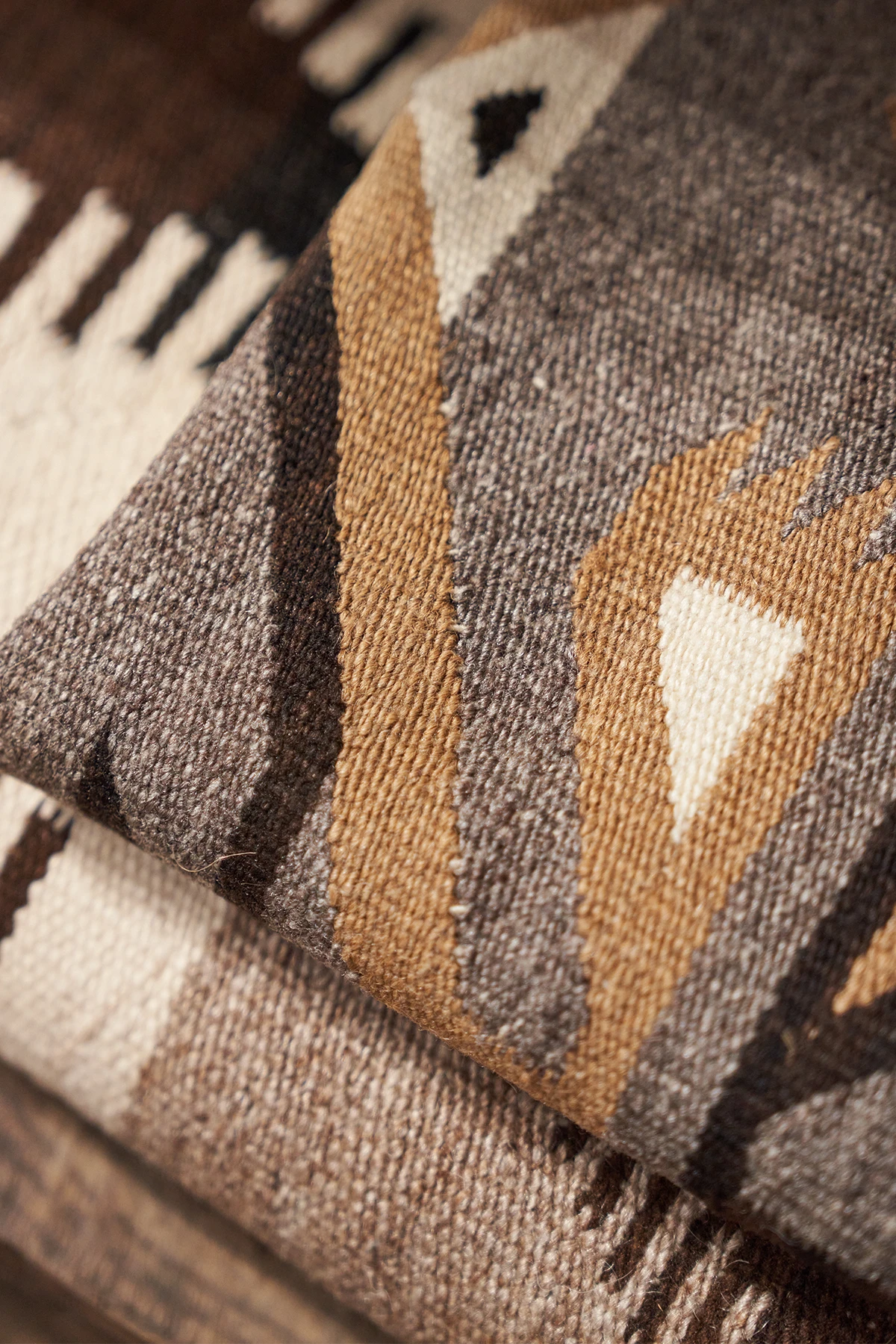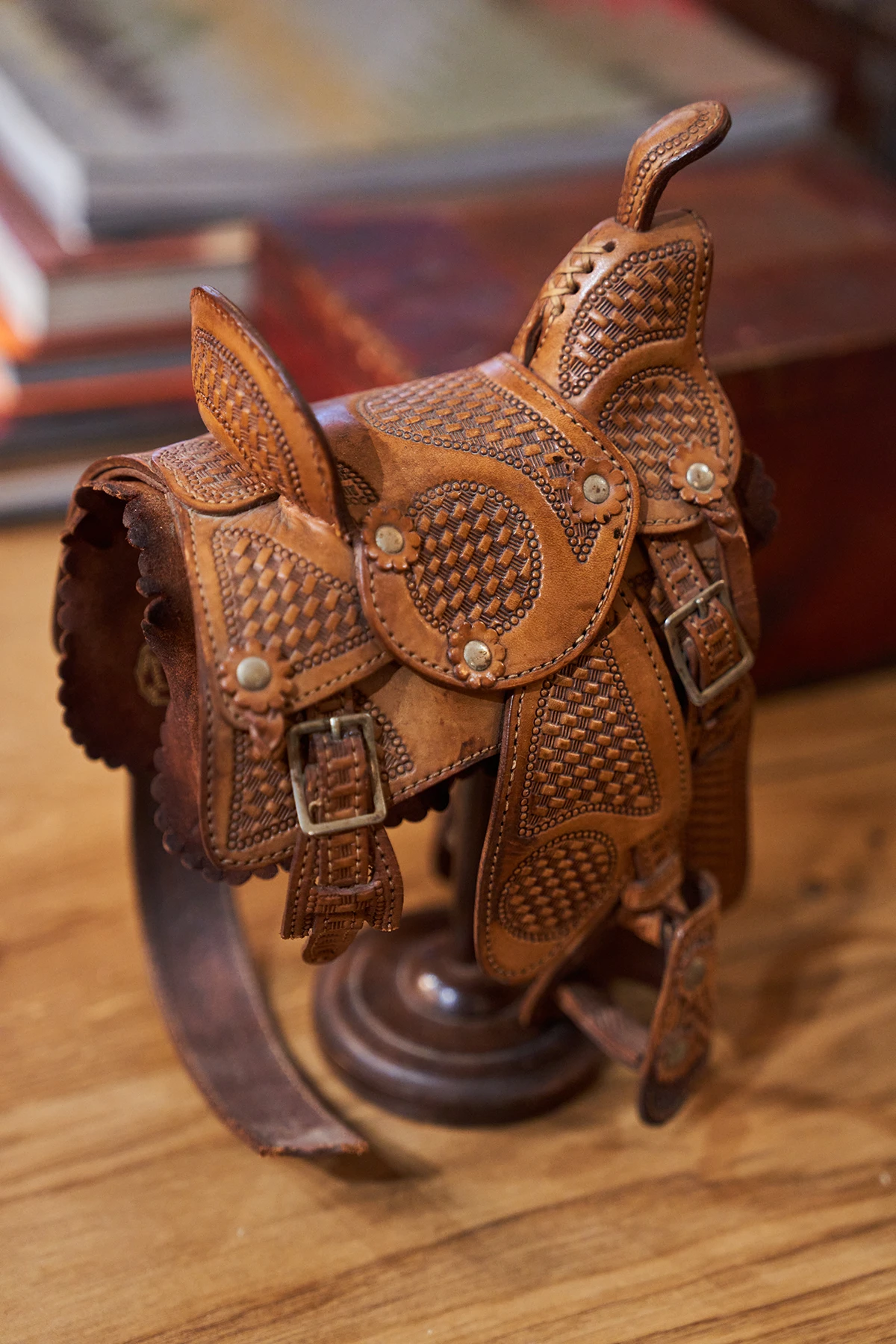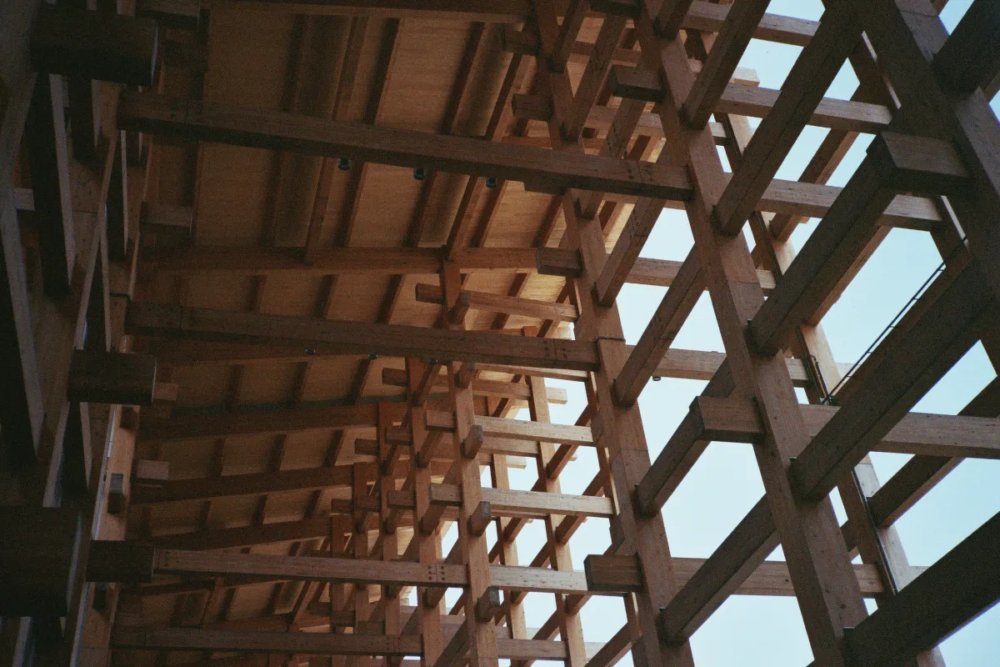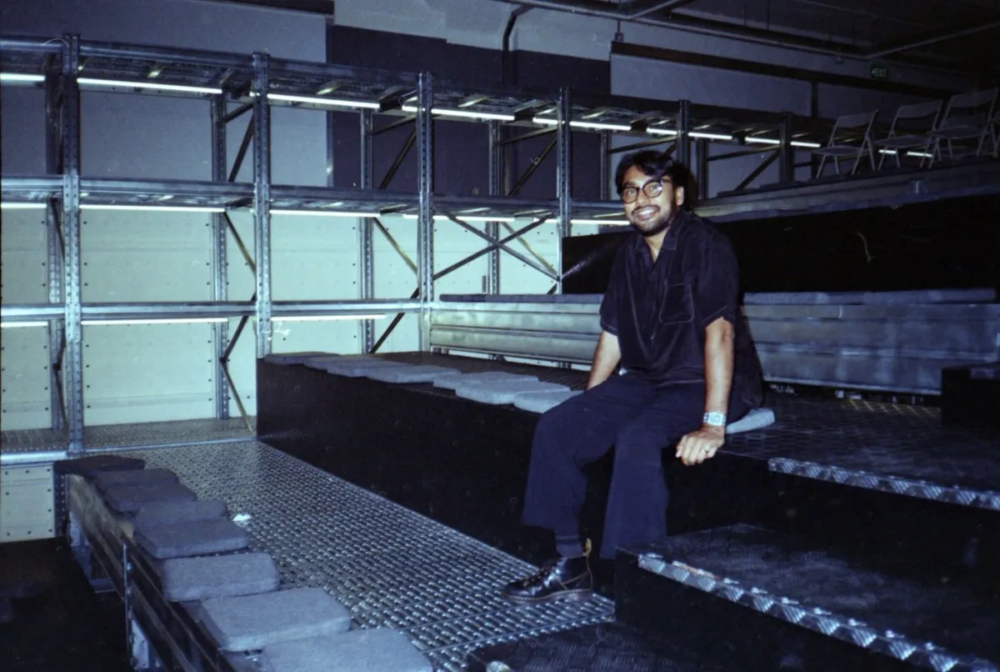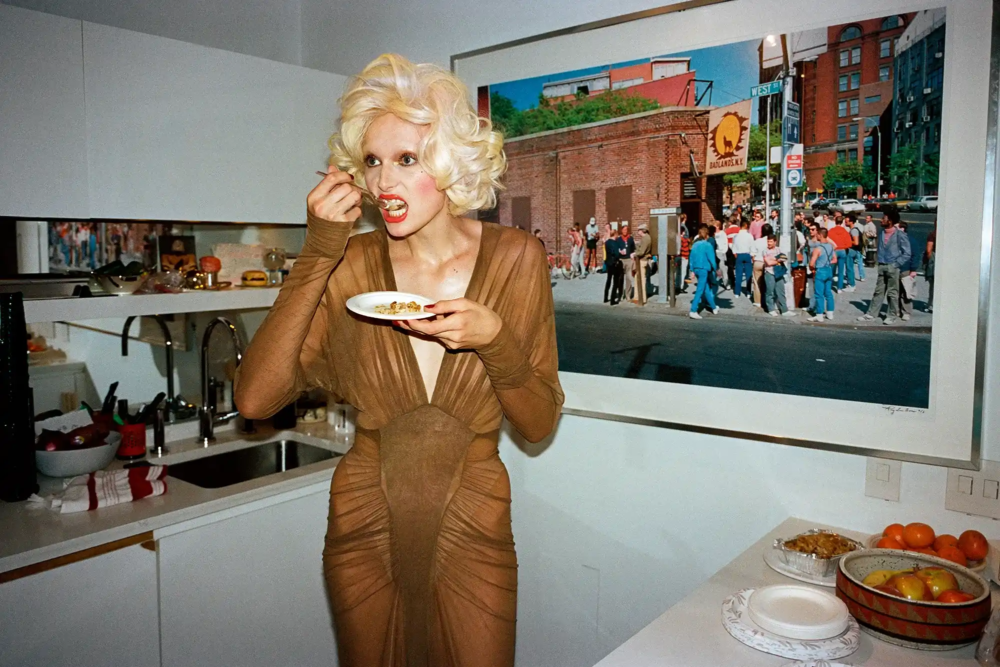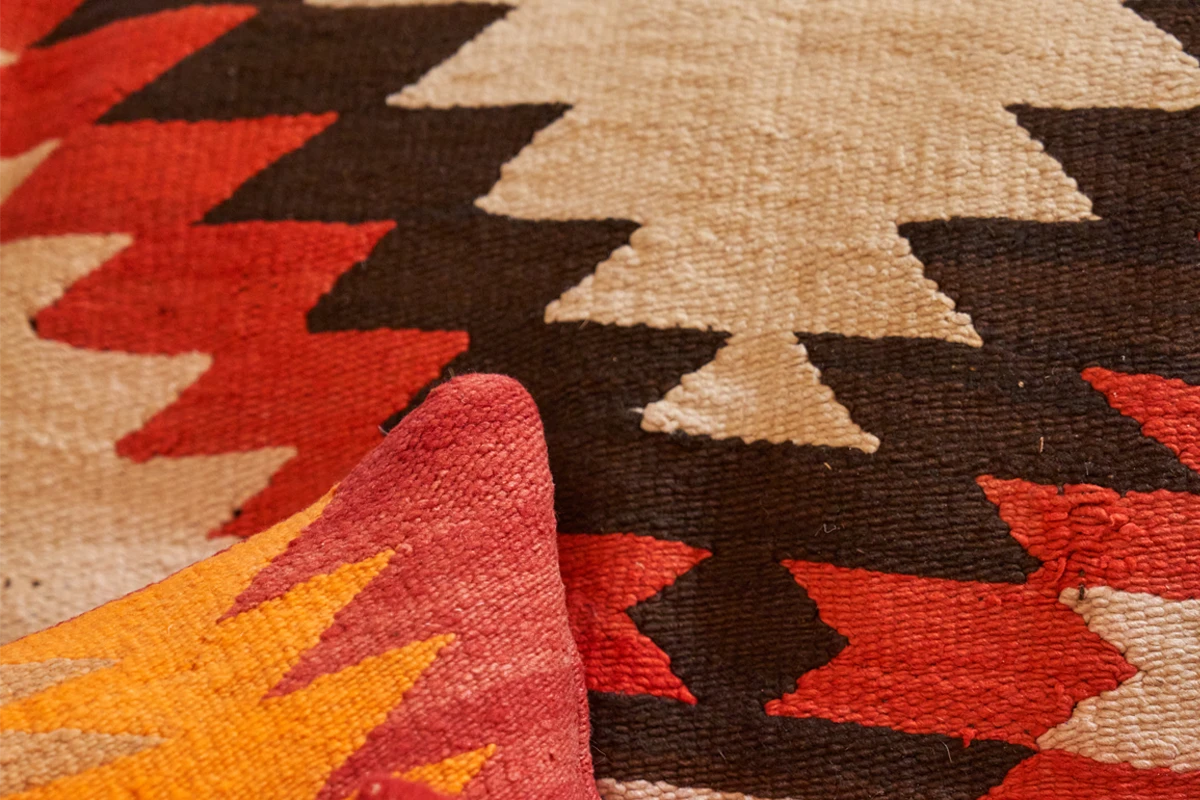
Rust and dust, Navajo weaving — “Canyon Road” by Ralph Lauren
For Ralph Lauren Home, two Diné artists—Naiomi and Tyler Glasses—bring geometric motifs, wool, and colors reminiscent of the ancient plant‑ and insect‑based dyes, embodying the sustainability of tradition
Canyon Road, Ralph Lauren Home – the art of the Navajo people
Diamonds, four‑direction crosses, and horizontal stripes appear on wool pillows and blankets that rest on beds and armchairs. Indigo, coal black, the brown of desert soil, the rusty red‑orange of oxidized rock. This is Canyon Road, the Ralph Lauren Home collection for Fall 2025, unveiled during the latest Fuorisalone in Milan. Its motifs and colors echo the art of the Navajo, an Indigenous nation of the American Southwest still based mainly in northern Arizona, with territory that also spans reservations in Utah and New Mexico.
The collaboration with Diné siblings Naiomi and Tyler Glasses
In Ralph Lauren’s own words: “The collection expresses my long‑standing love for the American West—the heroic beauty of its landscapes, its singular heritage, and the Indigenous peoples who have safeguarded its lands and traditions for centuries.” The East‑coast designer—the New Yorker who summers in the Hamptons—pays tribute to another face of the United States, one rougher, warmer, dustier. And he has not done so alone: “Bringing the most authentic expression of the West to life means working with the very artisans who keep these traditions alive and sharing their stories with the world.”
So Canyon Road was developed with two Navajo, or Diné, designers: Naiomi and Tyler Glasses, seventh‑generation weavers from Rock Point, Arizona, in Apache County—an area of 29,056 km² (about 11,215 sq mi), most of it still occupied by the Navajo Nation, the ancestral Dinétah. They carried into Canyon Road the art and symbolism handed down by their elders; it was their grandmother Nellie who taught them the ancient weaving techniques.
Naiomi Glasses, artist and skater, had already worked with Ralph Lauren. She opened the brand’s Artist‑in‑Residence program in 2023 with a three‑part Polo Ralph Lauren capsule: jacquard‑woven coats and capes in the natural hues of undyed wool, together with a reinterpretation of wedge‑weave Navajo patterns. These same patterns return in Canyon Road, animating the surfaces with waves and zigzags that ripple across the cloth. Unlike the straight weft we are used to—where the yarns run level—wedge weaving tilts them to create thrusts reminiscent of a wedge (and wedge, literally, means “cuneo”).

Navajo weaving – a heritage inherited from the Pueblo Indians
The roots of Navajo weaving in the Southwest actually pre‑date the Diné themselves. Legend says Spider Woman, a local deity, showed the people how to weave: the first loom, it is said, was strung with cords of sky and earth. Historically, it was the Pueblo who taught weaving to the Navajo, who had arrived from the north (Alaska and Canada). The Pueblo had been cultivating cotton for weaving since at least the fourteenth century, in a craft originally practiced only by men. They began finger‑weaving, then adopted the back‑strap loom they saw among Mexican Indigenous groups.
Over time cotton gave way to wool—the undisputed star of Canyon Road. Wool reached Navajo lands with the Spanish colonizers in the sixteenth century, along with previously unknown elements: striped motifs and indigo dye. As women joined the ranks of weavers, railroads were being laid through the Southwest. For the Navajo this opened the outside market: many an Eastern parlor was soon decorated with Diné rugs.
Chief’s blankets and “slave blankets” – Navajo geometry and Mexican influence
In the nineteenth century Indigenous women began weaving chief’s blankets, prized even by other nations such as the Plains tribes. Those blankets already carried some of the stylistic markers most identified with Navajo work today: four‑point geometric figures and black‑and‑white bands. Later, when Diné women were taken captive by Mexicans, they absorbed further influences—above all the large diamonds that from then on would dominate the centers of blankets and rugs. For this reason some still call them “slave blankets.”

Navajo art and color – natural dyes
Canyon Road is defined not only by Navajo symbols but also by Navajo colors: brown, gray, black, and white—the first palette of Diné creations, drawn from the fleeces of Churro sheep, a breed introduced by the Spanish. Their wool was washed with what the land offered, chiefly yucca root. After carding and spinning came dyeing, again using local resources: roots, earths, fungi, flowers, and in some cases insects. Some artisans still work this way, as the 2019 exhibition Through the Appalachian Forest: Field Explorations Illuminated by the Floyd Bartley Herbarium at Ohio University’s Kennedy Museum showed. Navajo artist Irene Clark dyed a rug with her grandmother’s recipes: lichens for rust tones, Artemisia tridentata for green. Weaver Lillie Taylor obtained green from sage and purple from cochineal, the carmine‑yielding insect native to Central America.
Cochineal was long used to create a spectrum of reds—one of the most iconic colors in Navajo art and one that Ralph Lauren Home sought to capture. Traditional alternatives include madder root (Rubia tinctorum, its Latin name speaks for itself) and local lichens such as Parmelia. From the nineteenth century onward, though, much Navajo red came from unraveling finished blankets that arrived in the territory, especially Spanish Bayeta: weavers dismantled them, separated the red yarns, then reincorporated that thread into new pieces.
Ralph Lauren’s Western passion and making historic tradition sustainable
For Ralph Lauren, Canyon Road is a further step into the landscapes of the Southwest, where he has also built a ranch at the foot of Colorado’s mountains. It is not the first. Alongside the collection launch, a retrospective at the Ralph Lauren Palazzo, Via San Barnaba 27, revived other styles explored in earlier years. Among its four chapters was “Western,” displaying four saddle‑tanned leather armchairs upholstered with red‑and‑black Navajo textiles, all beneath the Straton Triple‑Tier chandelier, fashioned from natural deer antlers.
Canyon Road nonetheless marks a shift in perspective for the brand. Like others, Ralph Lauren has in the past faced accusations of cultural appropriation—unlicensed use of Indigenous motifs and symbols, such as eagle feathers and war bonnets. Bringing Naiomi and Tyler Glasses into the design process is a conscious corrective: a move from mere inspiration to active collaboration with the very culture that has long fueled the designer’s imagination. It is a way to render historical tradition sustainable and to move beyond extractive impulses that might reopen still‑raw wounds.
The history of the Navajo Nation, from the Civil War to the present day
Like many Indigenous peoples, the Navajo story is marked by conflict and diaspora. One of its darkest chapters came during the American Civil War: in 1864 the federal government launched a military campaign against the Diné, deporting at least 8,000 people to Bosque Redondo, New Mexico. They were forced to walk 300 miles; many died. The ordeal is still remembered as the “Long Walk.” Only four years later did the Navajo return to their homeland. Under a treaty with Washington they were allowed to remain on a new reservation spanning three states—Arizona, Utah, and New Mexico.
Thus the Navajo Nation was born. Everything changed. Herding became the principal means of subsistence, alongside craftsmanship. The population kept growing and is now the largest of all Native American groups: estimates speak of about 250,000 residents on the reservation, with more than 400,000 including descendants elsewhere. The Diné continue to exercise self‑government through a political system modeled on the U.S. structure, with a president (Buu Nygren), vice‑president (Richelle Montoya), and bodies such as a Legislative Council and a Supreme Court.
By weaving Diné voices directly into its creative process, Ralph Lauren Home’s Canyon Road not only showcases the visual language of the Navajo—it ensures that the stories behind those diamonds, stripes, and vivid reds are told by the very people who have carried them forward for generations.
Giacomo Cadeddu

